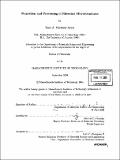| dc.contributor.advisor | Merton C. Flemings. | en_US |
| dc.contributor.author | Martínez-Ayers, Raúl Andrés, 1977- | en_US |
| dc.contributor.other | Massachusetts Institute of Technology. Dept. of Materials Science and Engineering. | en_US |
| dc.date.accessioned | 2005-09-27T18:51:44Z | |
| dc.date.available | 2005-09-27T18:51:44Z | |
| dc.date.copyright | 2004 | en_US |
| dc.date.issued | 2004 | en_US |
| dc.identifier.uri | http://hdl.handle.net/1721.1/28883 | |
| dc.description | Thesis (Ph. D.)--Massachusetts Institute of Technology, Dept. of Materials Science and Engineering, 2004. | en_US |
| dc.description | Includes bibliographical references (leaves 108-114). | en_US |
| dc.description.abstract | (cont.) given slurry was proposed. The fluidity of rheocast A357 alloy slurries was contrasted with the fluidity of superheated liquid. Rheocast slurries with 37% solid particles,were found to flow about half as far as fully liquid alloy superheated 20⁰C above the liquidus. | en_US |
| dc.description.abstract | The importance of semi-solid metal processing derives primarily from its ability to form high integrity parts from lightweight alloys. Since the discovery of the semi-solid metal microstructure, most part production was by reheating of billets which possessed a suitable microstructure ("thixocasting"). However, it is now apparent that there are significant advantages of forming semi-solid slurry directly from liquid alloy ("rheocasting") and efficient rheocasting processes have been engineered. In this work, experimental and analytical approaches were taken to study how non-dendritic microstructures form and evolve in Al-4.5wt%Cu alloy during the earliest stages of solidification. Experimental results showed that particles in quenched rheocast alloy were already spheroidal, and free of entrapped eutectic, after 5 seconds of solidification time. Spheroidal particles were also formed by reheating equiaxed dendrites of approximately 10 [micro]m radius above the eutectic temperature for 5 seconds, but these spheroids contained entrapped eutectic. In both rheocasting and reheating experiments, the average particle radius was found to increase with solidification time at a rate that closely follows the classical dendrite arm ripening curve. Particle growth models developed were compared with the average particle radius measurements, and particle solute content measurements. The maximum cooling rate to maintain spheroidal interface stability at various solid fractions was studied experimentally. A modified stability model which considered particle interaction through solute field overlap was developed and found to be in good agreement with experimental data. A simple method for the foundry to determine the maximum cooling rate for a | en_US |
| dc.description.statementofresponsibility | by Raul A. Martinez-Ayers. | en_US |
| dc.format.extent | 125 leaves | en_US |
| dc.format.extent | 5939357 bytes | |
| dc.format.extent | 5955125 bytes | |
| dc.format.mimetype | application/pdf | |
| dc.format.mimetype | application/pdf | |
| dc.language.iso | en_US | |
| dc.publisher | Massachusetts Institute of Technology | en_US |
| dc.rights | M.I.T. theses are protected by copyright. They may be viewed from this source for any purpose, but reproduction or distribution in any format is prohibited without written permission. See provided URL for inquiries about permission. | en_US |
| dc.rights.uri | http://dspace.mit.edu/handle/1721.1/7582 | |
| dc.subject | Materials Science and Engineering. | en_US |
| dc.title | Formation and processing of rheocast microstructures | en_US |
| dc.type | Thesis | en_US |
| dc.description.degree | Ph.D. | en_US |
| dc.contributor.department | Massachusetts Institute of Technology. Department of Materials Science and Engineering | |
| dc.identifier.oclc | 60426309 | en_US |
